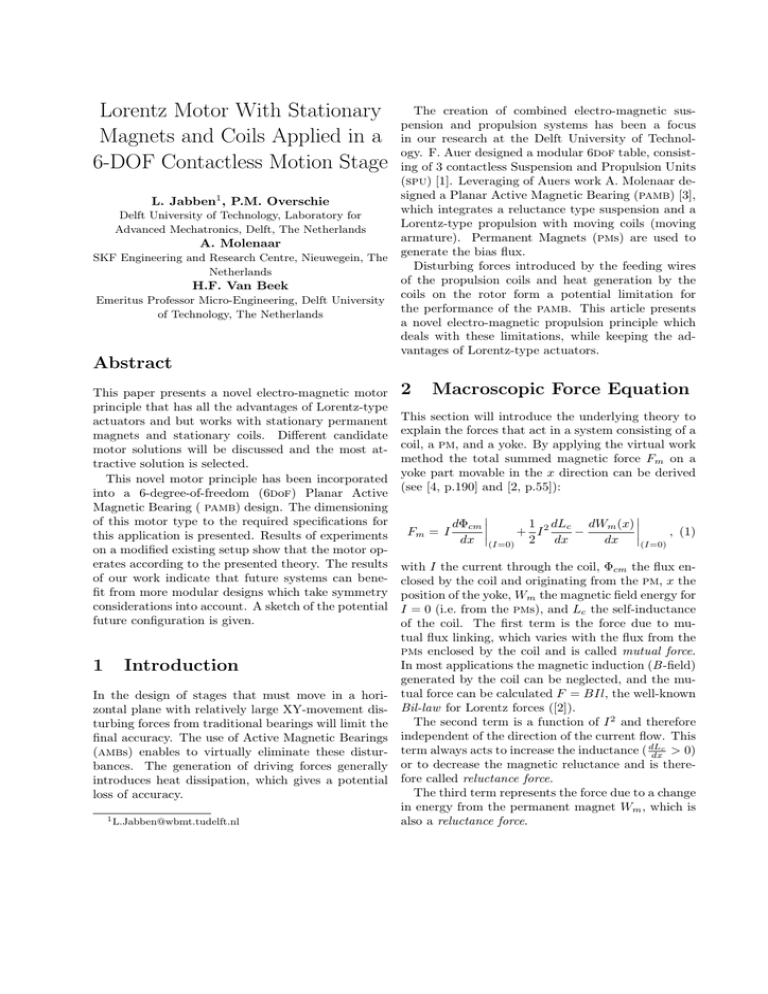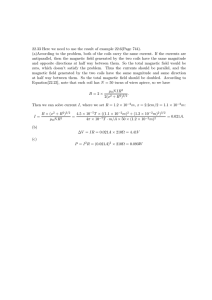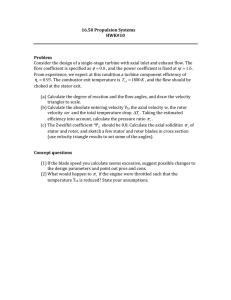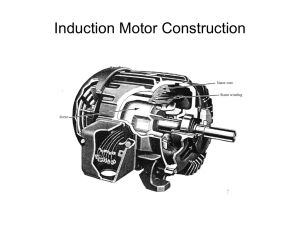Lorentz Motor With Stationary Magnets and Coils Applied in a 6
advertisement

Lorentz Motor With Stationary Magnets and Coils Applied in a 6-DOF Contactless Motion Stage L. Jabben1 , P.M. Overschie Delft University of Technology, Laboratory for Advanced Mechatronics, Delft, The Netherlands A. Molenaar SKF Engineering and Research Centre, Nieuwegein, The Netherlands H.F. Van Beek Emeritus Professor Micro-Engineering, Delft University of Technology, The Netherlands Abstract This paper presents a novel electro-magnetic motor principle that has all the advantages of Lorentz-type actuators and but works with stationary permanent magnets and stationary coils. Different candidate motor solutions will be discussed and the most attractive solution is selected. This novel motor principle has been incorporated into a 6-degree-of-freedom (6dof) Planar Active Magnetic Bearing ( pamb) design. The dimensioning of this motor type to the required specifications for this application is presented. Results of experiments on a modified existing setup show that the motor operates according to the presented theory. The results of our work indicate that future systems can benefit from more modular designs which take symmetry considerations into account. A sketch of the potential future configuration is given. 1 Introduction In the design of stages that must move in a horizontal plane with relatively large XY-movement disturbing forces from traditional bearings will limit the final accuracy. The use of Active Magnetic Bearings (ambs) enables to virtually eliminate these disturbances. The generation of driving forces generally introduces heat dissipation, which gives a potential loss of accuracy. 1 L.Jabben@wbmt.tudelft.nl The creation of combined electro-magnetic suspension and propulsion systems has been a focus in our research at the Delft University of Technology. F. Auer designed a modular 6dof table, consisting of 3 contactless Suspension and Propulsion Units (spu) [1]. Leveraging of Auers work A. Molenaar designed a Planar Active Magnetic Bearing (pamb) [3], which integrates a reluctance type suspension and a Lorentz-type propulsion with moving coils (moving armature). Permanent Magnets (pms) are used to generate the bias flux. Disturbing forces introduced by the feeding wires of the propulsion coils and heat generation by the coils on the rotor form a potential limitation for the performance of the pamb. This article presents a novel electro-magnetic propulsion principle which deals with these limitations, while keeping the advantages of Lorentz-type actuators. 2 Macroscopic Force Equation This section will introduce the underlying theory to explain the forces that act in a system consisting of a coil, a pm, and a yoke. By applying the virtual work method the total summed magnetic force Fm on a yoke part movable in the x direction can be derived (see [4, p.190] and [2, p.55]): Fm dΦcm 1 2 dLc dWm (x) − =I + I , (1) dx (I=0) 2 dx dx (I=0) with I the current through the coil, Φcm the flux enclosed by the coil and originating from the pm, x the position of the yoke, Wm the magnetic field energy for I = 0 (i.e. from the pms), and Lc the self-inductance of the coil. The first term is the force due to mutual flux linking, which varies with the flux from the pms enclosed by the coil and is called mutual force. In most applications the magnetic induction (B -field) generated by the coil can be neglected, and the mutual force can be calculated F = BIl, the well-known Bil-law for Lorentz forces ([2]). The second term is a function of I 2 and therefore independent of the direction of the current flow. This c term always acts to increase the inductance ( dL dx > 0) or to decrease the magnetic reluctance and is therefore called reluctance force. The third term represents the force due to a change in energy from the permanent magnet Wm , which is also a reluctance force. 3 Wireless Propulsion: Moving Iron not change with the position x because of the equally devided cupper. Thus a mutual (Lorentz) force is generated with F ∝ I. A qualitative check is to verify if the enclosed flux of the winding changes while A Lorentz force originates from the moving charges displacing the rotor. in a wire ’I’. Thus, a Newtonian reaction force must To understand better the difference in a classical act on the source of the magnetic flux density (B). approach and the moving iron principle consider Fig2 A novel drive concept , referred to as moving iron, ure 2. makes use of this reaction force. A rotor bar is driven by Lorentz forces without coils or magnets on it. Option A, C and D do not propel the rotor With option A shown in Figure 2, the enclosed flux 3.1 Working Principle will increase only with rotation. Hence only a bendTo understand the working principle of moving iron, ing moment on the rotor occurs. Option C (fixed consider a simple case as depicted in Figure 1. The I- to the rotor) will not work either because the enshaped rotor is assumed to be supported on bearings closed flux is invariant with position change. The that restrict movement to horizontal displacement3 . same holds for option D (alternatively, the Lorentz Furthermore, the ferromagnetic C-shaped stator yoke forces at both sides of the current loop will counteris considered an ideal flux guidance (µr = ∞). There- balance each other). fore, the stator part between permanent magnet and B air gap can be elongated without effect, which is indicated by the parallel line pair. Because the magnet D poles travel through the flux guidances towards the rotor N propulsion crossing of the bars that define the air gap, the flux direction S E A lines leave the stator at a position that moves along with the rotor iron. Thus the rotor behaves as a virtual source of B -field(!), while the actual pm can be C stator flux line positioned at a fixed position of the stator circuit. As a result, the reaction force of the Lorentz force act on Figure 2: Sketch of a simple linear drive showing five the rotor. optional drive schemes of which some will lead to a moving iron propulsion. stator rotor propulsion direction Coils N S flux line Option B, and E do propel To get a nett variation of the enclosed flux with a displacement, the return path of the current needs to be positioned outside the air gap region, which is the case with options B and E. Figure 1: Winding scheme for a moving iron driven 3.2 Moving Iron Winding Schemes rotor, with a spiral wrapped coil option. Moving iron requires a yoke configuration where the field moves with the rotor while the field source itSince the guiding flux bars are assumed to be ideal self (a permanent magnet or a field coil) is fixed at and the air gap height to be constant, the magnetic a remote position of the stator. This is the case in field energy term resulting from the pms Wm in (1), the setup shown in Figure 3, where five more practidoes not change with a horizontal change of position. cal moving iron winding schemes are depicted. OpFor the same reason the self inductance of the coil tions 1 and 2 are flat coils that are wound concencm is non-zero and does tric and with a blending displacement, respectively. will not change. The term Φdx These will deliver the same force as the winding op2 This concept is described in [4], but was not presented tion depicted in Figure 1 but with about 50% less before. 3 The suspension of the rotor is not discussed here, see [3, 4] power dissipation. 1 2 1 2 ... pair of upper and lower propulsion coils is series connected, thus assuring symmetrical loading. 1'2' ... N 1 2 ... ... 2' 1' S RIGHT propulsion coils Z Y 5 S S N 3 N X 4 N N S LEFT propulsion coils N N S S BACK propulsion coils Figure 3: Alternative winding schemes for a moving Figure 4: Planar active magnetic bearing with moviron driven rotor. Top: two flat would coil schemes. ing iron propulsion. Bottom: three buried coil options on salient poles. With options 3, 4 and 5 more ampère-turns can be coupled to the permanent magnet flux for a given motor length. However, parasitic reluctance forces will occur, called cogging. Option 5 has overlapping coils, which is beneficial for smooth and efficient commutation. 3.3 Advantages Active magnetic bearings utilizing the moving iron principle show three major advantages. First, the positioning accuracy of a moving iron setup is not limited by disturbing forces introduced by the feeding wires of the rotor coils. Secondly, the heat dissipated by the coils can be carried away through the stator material by conduction. Finally, a light weighted and compact linear driven rotor with planar freedom can be created that is not influenced by the size of the coils or the size of the permanent magnets used. 4 4.1 Towards a Prototype Practical Implementation The novel moving iron principle can be implemented by modifying the pamb set-up of Molenaar described in [3, 4]. The less complex moving iron winding scheme of Figure 1, was applied because of practical reasons, although this is not the most power efficient winding scheme. This is shown in Figure 4. Each 4.2 Dimensioning of the Coils Next the dimensioning of the coils in Figure 4 is discussed. The size of the flux guiding bars and the rotor (upper part of the T) is 20 × 20 mm2 . The total air gap between the rotor and stator is 1.1 mm. An aim in the design of the pamb is to have an accelleration of 1g. With a rotor mass of 3.5 kg, a force of 34.4 N is needed. Forces in the x-direction are generated by the left and right propulsion coils in a total of four air gaps. Assuming a B -field in the air gaps of 1 T, we can calculate with the Bil-law that the Ampère turns needed in one airgap is 429. This must be equal to the cross section area of the airgap (1×20 mm2 ) times the filling factor times the maximum current density (ρi,max ). Taking ρi,max equal to 33 A/mm2 , the gap filling factor that is needed is 65%. The maximum peak current that amplifier used in the setup can deliver is 4 A, which determines the minimum wire diameter to 0.39 mm. This means that we need two or three layers. To allow to probe the flux density in the test setup the stator is wound with one layer of a wire with 0.55 mm core and .58 mm outer diameter. This reduces the filling factor to 41% and ρi,max to 16.8 A/mm2 . The B -field realized in the test setup is 0.6 T. This results in a propulsion force of F = 0.6 · 1 · 20 · 0.41 · 16.8 · 20 · 10−3 = 1.65 N per air gap. Thus the total force is 4 · 1.65 = 6.6 N and the maximum acceleration 1.9 m/s2 . 4.3 Experimental Results The iron moving principle was applied to the pamb test set-up as descriped in [3, 4]. The obtained relevant results are given in the table below. Table 1: Experimental results of the pamb with the moving iron principle applied. characteristic square planar range [mm] suspended mass [kg] position stability ±2σ [nm] air gap height (clearance) [mm] magnetic induction [T] propulsion force [N] acceleration [m/s2 ] Aim 100 3 50 - (0.1) 1 9.81 Realized 130 3.37 75 1.1 (0.4) 0.6 6.5 1.9 Comparing the propulsion force calculated by the Bil-law of 6.6 N, with the realized propulsion force of 6.5 N, confirms that the propulsion force in the moving iron principle may be calculated using the Bil-law . Figure 5: An example setup for a 6 dof pamb with moving iron propulsion. 6 Conclusions A novel electro-magnetic motor principle has been designed an incorporated into a planar magnetic bearing system. The principle has all the properties of Lorentz-type actuators, while having stationary coils and magnets. The motor principle has been tested and fulfills our expectations. Finally, a sketch of a 5 Future Research novel motor-bearing design has been presented, utilizing the motor principle described. This modular The moving iron principle was successfully applied in and symmetrical setup seems very promising for apthe pamb. However magnetic cross-coupling between plications where ultra precise positioning and thermal the three bearing positions, the asymmetric layout management is of concern. of the pamb setup and the non-modularity prevents ultimate performance in positioning. Therefore a new design is suggested. References A modular design that utilizes the moving iron principle will allow further improvement of position- [1] Auer F. et al., “A Magnetically Levitated, Six Degrees of Freedom High Accuracy Positioning System”, Proc. ing accuracy. Figure 5 shows an example setup of of MAG’95, Magnetic Bearings, Magnetic Drives and three identical motor-bearing modules. Each module Dry Gas Seals, pp.176-185, 1995. independently suspends and propels one leg of a three legged rotor in 2dof, thus obtaining a 6dof pamb. [2] Hanselman, D.C., Brushless Permanent-Magnet Motor Design,McGraw-Hill, 1994. The propulsion force is exerted at the center of gravity in any planar position, while there is no magnetic [3] Molenaar, A., E.H. Zaaijer and H.F. van Beek, “A Novel Low Dissipation Long Stroke Planar Magnetic coupling between the three bearing positions. Suspension and Propulsion Stage”, Proc. 6th Int. No wires are attached to the rotor. Each motorSymp. on Magnetic Bearings, MIT, Cambridge, MA, bearing module consists of a U shaped stator circuit. USA, pp. 650-659, 1998. The working principle of the this stator circuit is similar to the working principle of the pamb, taking into [4] Molenaar, A., A Novel Planar Magnetic Bearing and Motor Configuration applied in a Positioning Stage, account only the left and the bottom part of the staPhD thesis, Delft University of Technology, The tor circuit shown in Figure 4 and ”bending” these toNetherlands, Delft, ISBN 90-6464-7372, 2000. wards each other. As Figure 5 shows a concept rather that a fixed setup, its layout can easily be adapted to fulfill the needs of future applications.


